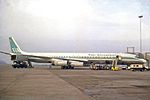Eastern Air Lines Flight 512

Eastern Air Lines Flight 512 was a scheduled domestic passenger flight from Charlotte, North Carolina, to New York City that crashed on November 30, 1962, killing 25 of the 51 people on board. The aircraft, a Douglas DC-7B operated by Eastern Air Lines, crashed at Idlewild Airport in heavy fog while attempting to perform a go-around. One of the plane's wings struck the ground and the plane crashed into soft sand in a marsh about 200 yards (180 m) from the runway, where it burst into flames. Emergency crews responded, but rescuers were delayed by the thick fog and the soft terrain. An investigation launched after the crash found that the probable cause of the accident was that the pilots had made critical mistakes during the go-around that prevented the aircraft from gaining altitude.
Excerpt from the Wikipedia article Eastern Air Lines Flight 512 (License: CC BY-SA 3.0, Authors, Images).Eastern Air Lines Flight 512
New York Queens
Geographical coordinates (GPS) Address Nearby Places Show on map
Geographical coordinates (GPS)
| Latitude | Longitude |
|---|---|
| N 40.641 ° | E -73.807 ° |
Address
Queens
New York, Queens
New York, United States
Open on Google Maps








